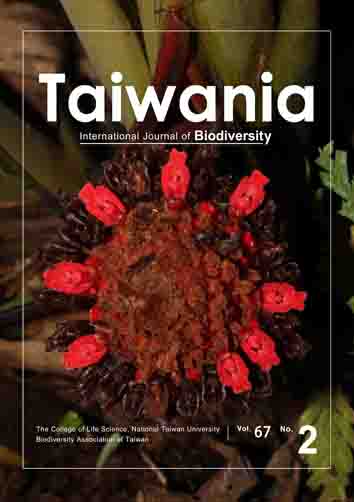Research Paper
Introduction of a non-native lineage is linked to the recent black cocoa ant, Dolichoderus thoracicus (Smith, 1860), outbreaks in Taiwan
Feng-Chuan Hsu, Shu-Ping Tseng, Po-Wei Hsu, Chia-Wei Lu, Chin-Cheng Scotty Yang, Chung-Chi Lin
Published on: 04 May 2022
Page: 271 - 279
DOI: 10.6165/tai.2022.67.271
Abstract
The black cocoa ant, Dolichoderus thoracicus (Smith), is widely distributed across the Indomalayan region including Taiwan. Until the recent localized outbreaks in central Taiwan, this ant has never been considered as a pest. The current study tested if an introduction of non-native lineage(s) potentially contributes to the ant’s sudden outbreaks in Taiwan by analyzing phylogenetic relationships of D. thoracicus in Taiwan and Southeast Asia. Our results showed that all ants were grouped into two major mitochondrial clades (Clade I and II) separated by a p-distance of 0.0414. Clade I is widespread in Taiwan and represented by six haplotypes that are genetically similar to the haplotypes from the Philippines, indicating that these ants are likely a result of range expansion of the Philippine lineage(s). In contrast, ants from central Taiwan harbor a single Clade II haplotype that is predominantly found in the samples collected from the Indochina region. Coupled with the low genetic diversity, Clade II D. thoracicus in Taiwan was most likely introduced from the Indochina region. The possibility is further supported by the fact that most D. thoracicus intercepted at the Taiwanese borders had an Indochina origin. Overall, this study suggests that a non-native lineage is responsible for the recent outbreaks of this ant in Taiwan, highlighting a potential research avenue for future research on the association between the “pest” trait and non-native genetic variant in invaded area.
Keyword: Biogeography, biological invasions, Dolichoderinae, Formicidae, Hymenoptera, Indomalayan region, insect pest
Literature Cited
Abouheif, E. and G.A. Wray. 2002. Evolution of the gene network underlying wing polyphenism in ants. Science 297(5579): 249?252.
DOI: 10.1126/science.1071468View Article
Google Scholar
Ascunce, M.S., C.-C. Yang, J. Oakey, L. Calcaterra, W.-J. Wu, C.-J. Shih, J. Goudet, K.G. Ross and D. Shoemaker. 2011. Global invasion history of the fire ant Solenopsis invicta. Science 331(6020): 1066?1068.
DOI: 10.1126/science.1198734View Article
Google Scholar
Barabag, Z. and W. Jaitrong. 2022. A new species of the ant genus Dolichoderus Lund, 1831 (Hymenoptera, Formicidae) from Thailand. Sociobiology 69(1): e6247.
DOI: 10.13102/sociobiology.v69i1.6247View Article
Google Scholar
Bertelsmeier, C., S. Ollier, A. Liebhold and L. Keller. 2017. Recent human history governs global ant invasion dynamics. Nat. Ecol. Evol. 1(7): 0184.
DOI: 10.1038/s41559-017-0184View Article
Google Scholar
Bertelsmeier, C., S. Ollier, A.M. Liebhold, E.G. Brockerhoff, D. Ward and L. Keller. 2018. Recurrent bridgehead effects accelerate global alien ant spread. PNAS 115(21): 5486?5491.
DOI: 10.1073/pnas.1801990115View Article
Google Scholar
Bolton, B. 2022. An online catalog of the ants of the world (AntCat). [Accessed on 15 March 2022] https://antcat.org.
Brown, S.D., R.A. Collins, S. Boyer, M.C. Lefort, J.A.G.O.B.A. Malumbres?Olarte, C.J. Vink and R.H. Cruickshank. 2012. Spider: an R package for the analysis of species identity and evolution, with particular reference to DNA barcoding. Mol. Ecol. Resour. 12(3): 562?565.
DOI: 10.1111/j.1755-0998.2011.03108.xView Article
Google Scholar
Chang, C.-C. and M.-Y. Lin. 2015. Ant ecology in orchards and control efficiency using boric acid baits. Bulletin of Tainan District Agricultural Research Extension Station 91: 20?24. (In Vhinese)
Chernomor, O., A. von Haeseler and B.Q. Minh. 2016. Terrace aware data structure for phylogenomic inference from supermatrices. Syst. Biol. 65(6): 997?1008.
DOI: 10.1093/sysbio/syw037View Article
Google Scholar
Clouse, R.M., M. Janda, B. Blanchard, P. Sharma, B.D. Hoffmann, A.N. Andersen, J.E. Czekanski-Moir, P. Krushelnycky, C. Rabeling, E.O. Wilson, E.P. Economo, E.M. Sarnat, D.M. General, G.D. Alpert and W.C. Wheeler. 2015. Molecular phylogeny of Indo-Pacific carpenter ants (Hymenoptera: Formicidae, Camponotus) reveals waves of dispersal and colonization from diverse source areas. Cladistics 31(4): 424?437.
DOI: 10.1111/cla.12099View Article
Google Scholar
Corin, S.E., P.J. Lester, K.L. Abbott and P.A. Ritchie. 2007. Inferring historical introduction pathways with mitochondrial DNA: the case of introduced Argentine ants (Linepithema humile) into New Zealand. Divers. Distrib. 13(5): 510?518.
DOI: 10.1111/j.1472-4642.2007.00355.xView Article
Google Scholar
Corr?a, A.S., E.M. Cordeiro and C. Omoto. 2019. Agricultural insect hybridization and implications for pest management. Pest Manag. Sci. 75(11): 2857?2864.
DOI: 10.1002/ps.5495View Article
Google Scholar
Dill, M., D.J. Williams and U. Maschwitz. 2002. Herdsmen ants and their mealybug partners. Abhandlungen der Senckenbergischen Naturforschenden Gesellschaft 557: 1?373.
Donisthorpe, H. 1932. On the identity of Smith's types of Formicidae (Hymenoptera) collected by Alfred Russell Wallace in the Malay Archipelago, with descriptions of two new species. Ann. Mag. Nat. Hist. 10(59): 441?476.
DOI: 10.1080/00222933208673595View Article
Google Scholar
Folmer, O., M. Black, W. Hoeh, R. Lutz and R. Vrijenhoek. 1994. DNA primers for amplification of mitochondrial cytochrome c oxidase subunit I from diverse metazoan invertebrates. Mol. Mar. Biol. Biotechnol. 3(5): 294–299.
Forel, A. 1912. H. Sauter's Formosa-Ausbeute. Formicidae (Hym.). Entomol. Mitt. 1: 45?61.
DOI: 10.5962/bhl.part.25896View Article
Google Scholar
Fournier, D., M. Tindo, M. Kenne, P.S.M. Masse, V. Van Bossche, E. De Coninck and S. Aron. 2012. Genetic structure, nestmate recognition and behaviour of two cryptic species of the invasive big-headed ant Pheidole megacephala. PLoS ONE 7(2): e31480.
DOI: 10.1371/journal.pone.0031480View Article
Google Scholar
Gaigher, R., M.J. Samways, J. Henwood and K. Jolliffe. 2011. Impact of a mutualism between an invasive ant and honeydew-producing insects on a functionally important tree on a tropical island. Biol. Invasions 13(8): 1717?1721.
DOI: 10.1007/s10530-010-9934-1View Article
Google Scholar
Gu?nard, B., M. Weiser, K. Gomez, N. Narula and E.P. Economo. 2017. The Global Ant Biodiversity Informatics (GABI) database: a synthesis of ant species geographic distributions. Myrmecol. News 24: 83?89.
Guindon, S., J.F. Dufayard, V. Lefort, M. Anisimova, W. Hordijk and O. Gascuel. 2010. New algorithms and methods to estimate maximum-likelihood phylogenies: assessing the performance of PhyML 3.0. Syst. Biol. 59(3): 307?321.
DOI: 10.1093/sysbio/syq010View Article
Google Scholar
Helms, K.R. and S.B. Vinson. 2008. Plant resources and colony growth in an invasive ant: the importance of honeydew-producing hemiptera in carbohydrate transfer across trophic levels. Environ. Entomol. 37(2): 487?493.
DOI: 10.1093/ee/37.2.487View Article
Google Scholar
Hoang, D.T., O. Chernomor, A. Von Haeseler, B.Q. Minh and L.S. Vinh. 2018. UFBoot2: Improving the ultrafast bootstrap approximation. Mol. Biol. Evol. 35(2): 518–522.
DOI: 10.1093/molbev/msx281View Article
Google Scholar
Huang, J.-Y. 2018. Special lecture: Preventive strategy for harmful ant species. Nature Conservation Quarterly 103: 86?87. (In Chinese)
Hulme, P.E. 2009. Trade, transport and trouble: managing invasive species pathways in an era of globalization. J. Appl. Ecol. 46(1): 10?18.
DOI: 10.1111/j.1365-2664.2008.01600.xView Article
Google Scholar
Janicki, J., N. Narula, M. Ziegler, B. Gu?nard and E.P. Economo. 2016. Visualizing and interacting with large-volume biodiversity data using client-server web-mapping applications: The design and implementation of antmaps.org. Ecol. Inform. 32: 185?193.
DOI: 10.1016/j.ecoinf.2016.02.006View Article
Google Scholar
Jeschke, J.M. and J. Starzer. 2018. Propagule pressure hypothesis. In: Jeschke JM, Heger T (eds), Invasion biology: hypotheses and evidence. CABI, Wallingford, UK, pp 147?153.
DOI: 10.1079/9781780647647.0147View Article
Google Scholar
Kalyaanamoorthy, S., B.Q. Minh, T.K.F. Wong, A. Von Haeseler and L.S. Jermiin. 2017. ModelFinder: Fast model selection for accurate phylogenetic estimates. Nat. Methods 14(6): 587–589.
DOI: 10.1038/nmeth.4285View Article
Google Scholar
Kumar, S., G. Stecher and K. Tamura. 2016. MEGA7: molecular evolutionary genetics analysis version 7.0 for bigger datasets. Mol. Biol. Evol. 33(7): 1870?1874.
DOI: 10.1093/molbev/msw054View Article
Google Scholar
Lai, C.-J. 2019. The black cocoa ants invading orchards and representing an emerging nuisance in Xihu Township; the Council of Agriculture offering help in preventing ant invasion. Bulletin of Miaoli District Agricultural Research Extension Station 240: 4. (In Chinese)
Lee, C.-C., Y.-M. Weng, L.-C. Lai, A.V. Suarez, W.-J. Wu, C.-C. Lin, and C.-C.S. Yang. 2020. Analysis of recent interception records reveals frequent transport of arboreal ants and potential predictors for ant invasion in Taiwan. Insects 11(6): 356.
DOI: 10.3390/insects11060356View Article
Google Scholar
Leigh, J.W. and D. Bryant. 2015. PopART: Full-feature software for haplotype network construction. Methods Ecol. Evol. 6(9): 1110?1116.
DOI: 10.1111/2041-210X.12410View Article
Google Scholar
Lin, C.C., T.W. Chang, H.W. Chen, C.H. Shih and P.C. Hsu. 2017. Development of liquid bait with unique bait station for control of Dolichoderus thoracicus (Hymenoptera: Formicidae). J. Econ. Entomol. 110(4): 1685?1692.
DOI: 10.1093/jee/tox107View Article
Google Scholar
Meyerson, L.A. and H.A. Mooney. 2007. Invasive alien species in an era of globalization. Front. Ecol. Environ. 5(4): 199?208.
DOI: 10.1890/1540-9295(2007)5[199:IASIAE]2.0.CO;2View Article
Google Scholar
Mikheyev, A.S. 2008. History, genetics and pathology of a leaf-cutting ant introduction: a case study of the Guadeloupe invasion. Biol. Invasions 10(4): 467?473.
DOI: 10.1007/s10530-007-9144-7View Article
Google Scholar
Nguyen, L.T., H.A. Schmidt, A. Von Haeseler and B.Q. Minh. 2015. IQ-TREE: A fast and effective stochastic algorithm for estimating maximum likelihood phylogenies. Mol. Biol. Evol. 32(1): 268–274.
DOI: 10.1093/molbev/msu300View Article
Google Scholar
Rozas, J., A. Ferrer-Mata, J.C. S?nchez-DelBarrio, S. Guirao-Rico, P. Librado, S.E. Ramos-Onsins, A. S?nchez-Gracia. 2017. DnaSP 6: DNA Sequence Polymorphism Analysis of Large Datasets. Mol. Biol. Evol. 34(12): 3299–3302.
DOI: 10.1093/molbev/msx248View Article
Google Scholar
Schultz, T.R. and S.G. Brady. 2008. Major evolutionary transitions in ant agriculture. PNAS 105(14): 5435?5440.
DOI: 10.1073/pnas.0711024105View Article
Google Scholar
Shi, J., M. Macel, K. Tielbo?rger and K.J. Verhoeven. 2018. Effects of admixture in native and invasive populations of Lythrum salicaria. Biol. Invasions 20(9): 2381?2393.
DOI: 10.1007/s10530-018-1707-2View Article
Google Scholar
Shattuck, S.O. and S. Marsden. 2013. Australian species of the ant genus Dolichoderus (Hymenoptera: Formicidae). Zootaxa 3716(2): 101–143.
DOI: 10.11646/zootaxa.3716.2.1View Article
Google Scholar
Sonan, J. 1939. Ants in dwelling houses, with a list of the Formosan ants. In: Thirty Anniversary Memorial Publication of the Natural History of Formosa. Taihoku, pp. 187?218. (In Japanese)
Suarez, A.V., D.A. Holway and T.J. Case. 2001. Patterns of spread in biological invasions dominated by long-distance jump dispersal: insights from Argentine ants. PNAS 98(3): 1095?1100.
DOI: 10.1073/pnas.98.3.1095View Article
Google Scholar
Terayama, M. 2009. A synopsis of the family Formicidae of Taiwan. Research Bulletin of Kanto Gakuen University. Liberal Arts 17: 81?266.
Trifinopoulos, J., L.T. Nguyen, A. Von Haeseler and B.Q. Minh. 2016. W-IQ-TREE: a fast online phylogenetic tool for maximum likelihood analysis. Nucleic Acids Res. 44: W232–W235.
DOI: 10.1093/nar/gkw256View Article
Google Scholar
Tseng, S.-P., J.K. Wetterer, A.V. Suarez, C.-Y. Lee, T. Yoshimura, D.D. Shoemaker and C.-C.S. Yang. 2019. Genetic diversity and Wolbachia infection patterns in a globally distributed invasive ant. Front. Genet. 10: 838.
DOI: 10.3389/fgene.2019.00838View Article
Google Scholar
Tsutsui, N.D., A.V. Suarez, D.A. Holway and T.J. Case. 2001. Relationships among native and introduced populations of the Argentine ant (Linepithema humile) and the source of introduced populations. Mol. Ecol. 10(9): 2151?2161.
DOI: 10.1046/j.0962-1083.2001.01363.xView Article
Google Scholar
Ward, P.S. and D.A. Downie. 2005. The ant subfamily Pseudomyrmecinae (Hymenoptera: Formicidae): phylogeny and evolution of big?eyed arboreal ants. Syst. Entomol. 30(2): 310?335.
DOI: 10.1111/j.1365-3113.2004.00281.xView Article
Google Scholar
Wittman, S.E., D.J. O'Dowd and P.T. Green. 2018. Carbohydrate supply drives colony size, aggression, and impacts of an invasive ant. Ecosphere 9(9): e02403.
DOI: 10.1002/ecs2.2403View Article
Google Scholar


